FDN121 Business Law: Exploring Contract Law & Negligence in AU
VerifiedAdded on 2023/06/04
|9
|2701
|201
Report
AI Summary
This assignment provides a comprehensive overview of contract law and negligence in Australia, addressing key elements, case laws, and legal principles. The first part focuses on contract law, differentiating between verbal and written contracts, outlining the essential elements of a valid contract (offer, acceptance, intention, consideration, and competence), and explaining the terms and conditions, standard form contracts, unfair terms, and methods of ending a contract. The second part delves into the law of negligence, detailing the elements necessary to establish negligence: duty of care, breach of duty, causation, and remoteness of damages, supported by relevant case laws such as Donoghue v Stevenson and Wagon Mound no 1. This document offers a robust understanding of these critical aspects of Australian business law.

Business Law
Paraphrase This Document
Need a fresh take? Get an instant paraphrase of this document with our AI Paraphraser
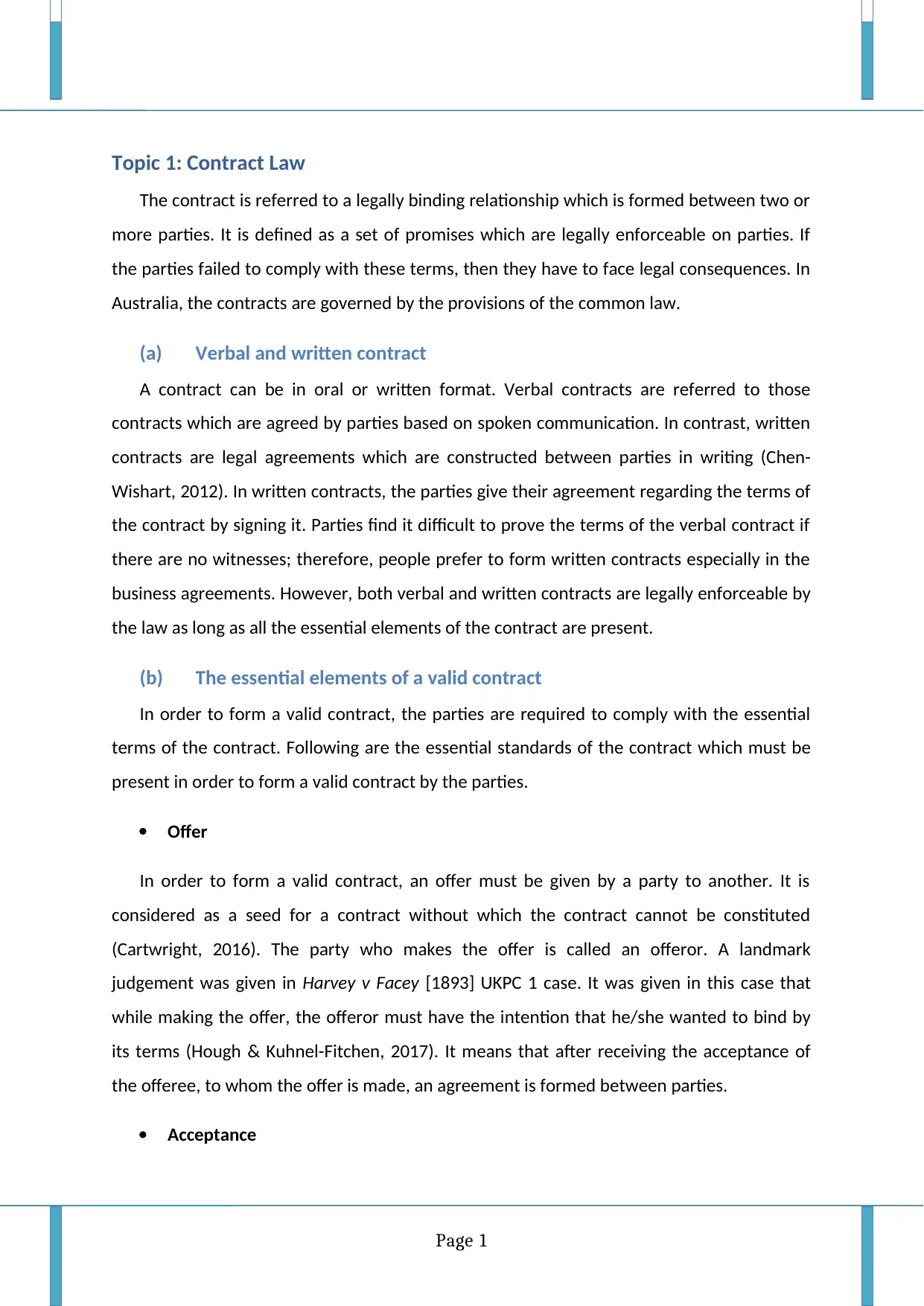
Topic 1: Contract Law
The contract is referred to a legally binding relationship which is formed between two or
more parties. It is defined as a set of promises which are legally enforceable on parties. If
the parties failed to comply with these terms, then they have to face legal consequences. In
Australia, the contracts are governed by the provisions of the common law.
(a) Verbal and written contract
A contract can be in oral or written format. Verbal contracts are referred to those
contracts which are agreed by parties based on spoken communication. In contrast, written
contracts are legal agreements which are constructed between parties in writing (Chen-
Wishart, 2012). In written contracts, the parties give their agreement regarding the terms of
the contract by signing it. Parties find it difficult to prove the terms of the verbal contract if
there are no witnesses; therefore, people prefer to form written contracts especially in the
business agreements. However, both verbal and written contracts are legally enforceable by
the law as long as all the essential elements of the contract are present.
(b) The essential elements of a valid contract
In order to form a valid contract, the parties are required to comply with the essential
terms of the contract. Following are the essential standards of the contract which must be
present in order to form a valid contract by the parties.
Offer
In order to form a valid contract, an offer must be given by a party to another. It is
considered as a seed for a contract without which the contract cannot be constituted
(Cartwright, 2016). The party who makes the offer is called an offeror. A landmark
judgement was given in Harvey v Facey [1893] UKPC 1 case. It was given in this case that
while making the offer, the offeror must have the intention that he/she wanted to bind by
its terms (Hough & Kuhnel-Fitchen, 2017). It means that after receiving the acceptance of
the offeree, to whom the offer is made, an agreement is formed between parties.
Acceptance
Page 1
The contract is referred to a legally binding relationship which is formed between two or
more parties. It is defined as a set of promises which are legally enforceable on parties. If
the parties failed to comply with these terms, then they have to face legal consequences. In
Australia, the contracts are governed by the provisions of the common law.
(a) Verbal and written contract
A contract can be in oral or written format. Verbal contracts are referred to those
contracts which are agreed by parties based on spoken communication. In contrast, written
contracts are legal agreements which are constructed between parties in writing (Chen-
Wishart, 2012). In written contracts, the parties give their agreement regarding the terms of
the contract by signing it. Parties find it difficult to prove the terms of the verbal contract if
there are no witnesses; therefore, people prefer to form written contracts especially in the
business agreements. However, both verbal and written contracts are legally enforceable by
the law as long as all the essential elements of the contract are present.
(b) The essential elements of a valid contract
In order to form a valid contract, the parties are required to comply with the essential
terms of the contract. Following are the essential standards of the contract which must be
present in order to form a valid contract by the parties.
Offer
In order to form a valid contract, an offer must be given by a party to another. It is
considered as a seed for a contract without which the contract cannot be constituted
(Cartwright, 2016). The party who makes the offer is called an offeror. A landmark
judgement was given in Harvey v Facey [1893] UKPC 1 case. It was given in this case that
while making the offer, the offeror must have the intention that he/she wanted to bind by
its terms (Hough & Kuhnel-Fitchen, 2017). It means that after receiving the acceptance of
the offeree, to whom the offer is made, an agreement is formed between parties.
Acceptance
Page 1
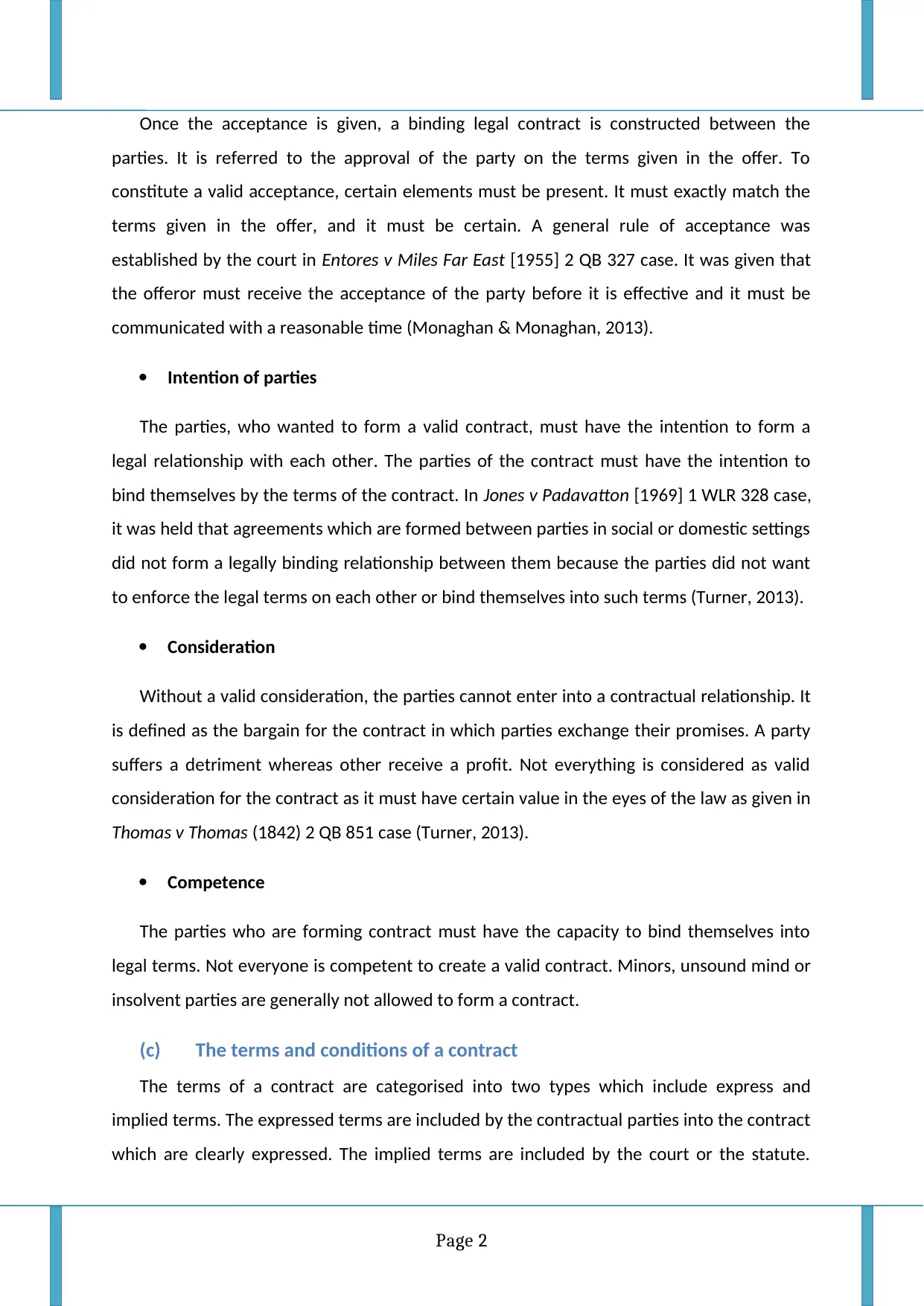
Once the acceptance is given, a binding legal contract is constructed between the
parties. It is referred to the approval of the party on the terms given in the offer. To
constitute a valid acceptance, certain elements must be present. It must exactly match the
terms given in the offer, and it must be certain. A general rule of acceptance was
established by the court in Entores v Miles Far East [1955] 2 QB 327 case. It was given that
the offeror must receive the acceptance of the party before it is effective and it must be
communicated with a reasonable time (Monaghan & Monaghan, 2013).
Intention of parties
The parties, who wanted to form a valid contract, must have the intention to form a
legal relationship with each other. The parties of the contract must have the intention to
bind themselves by the terms of the contract. In Jones v Padavatton [1969] 1 WLR 328 case,
it was held that agreements which are formed between parties in social or domestic settings
did not form a legally binding relationship between them because the parties did not want
to enforce the legal terms on each other or bind themselves into such terms (Turner, 2013).
Consideration
Without a valid consideration, the parties cannot enter into a contractual relationship. It
is defined as the bargain for the contract in which parties exchange their promises. A party
suffers a detriment whereas other receive a profit. Not everything is considered as valid
consideration for the contract as it must have certain value in the eyes of the law as given in
Thomas v Thomas (1842) 2 QB 851 case (Turner, 2013).
Competence
The parties who are forming contract must have the capacity to bind themselves into
legal terms. Not everyone is competent to create a valid contract. Minors, unsound mind or
insolvent parties are generally not allowed to form a contract.
(c) The terms and conditions of a contract
The terms of a contract are categorised into two types which include express and
implied terms. The expressed terms are included by the contractual parties into the contract
which are clearly expressed. The implied terms are included by the court or the statute.
Page 2
parties. It is referred to the approval of the party on the terms given in the offer. To
constitute a valid acceptance, certain elements must be present. It must exactly match the
terms given in the offer, and it must be certain. A general rule of acceptance was
established by the court in Entores v Miles Far East [1955] 2 QB 327 case. It was given that
the offeror must receive the acceptance of the party before it is effective and it must be
communicated with a reasonable time (Monaghan & Monaghan, 2013).
Intention of parties
The parties, who wanted to form a valid contract, must have the intention to form a
legal relationship with each other. The parties of the contract must have the intention to
bind themselves by the terms of the contract. In Jones v Padavatton [1969] 1 WLR 328 case,
it was held that agreements which are formed between parties in social or domestic settings
did not form a legally binding relationship between them because the parties did not want
to enforce the legal terms on each other or bind themselves into such terms (Turner, 2013).
Consideration
Without a valid consideration, the parties cannot enter into a contractual relationship. It
is defined as the bargain for the contract in which parties exchange their promises. A party
suffers a detriment whereas other receive a profit. Not everything is considered as valid
consideration for the contract as it must have certain value in the eyes of the law as given in
Thomas v Thomas (1842) 2 QB 851 case (Turner, 2013).
Competence
The parties who are forming contract must have the capacity to bind themselves into
legal terms. Not everyone is competent to create a valid contract. Minors, unsound mind or
insolvent parties are generally not allowed to form a contract.
(c) The terms and conditions of a contract
The terms of a contract are categorised into two types which include express and
implied terms. The expressed terms are included by the contractual parties into the contract
which are clearly expressed. The implied terms are included by the court or the statute.
Page 2
⊘ This is a preview!⊘
Do you want full access?
Subscribe today to unlock all pages.

Trusted by 1+ million students worldwide
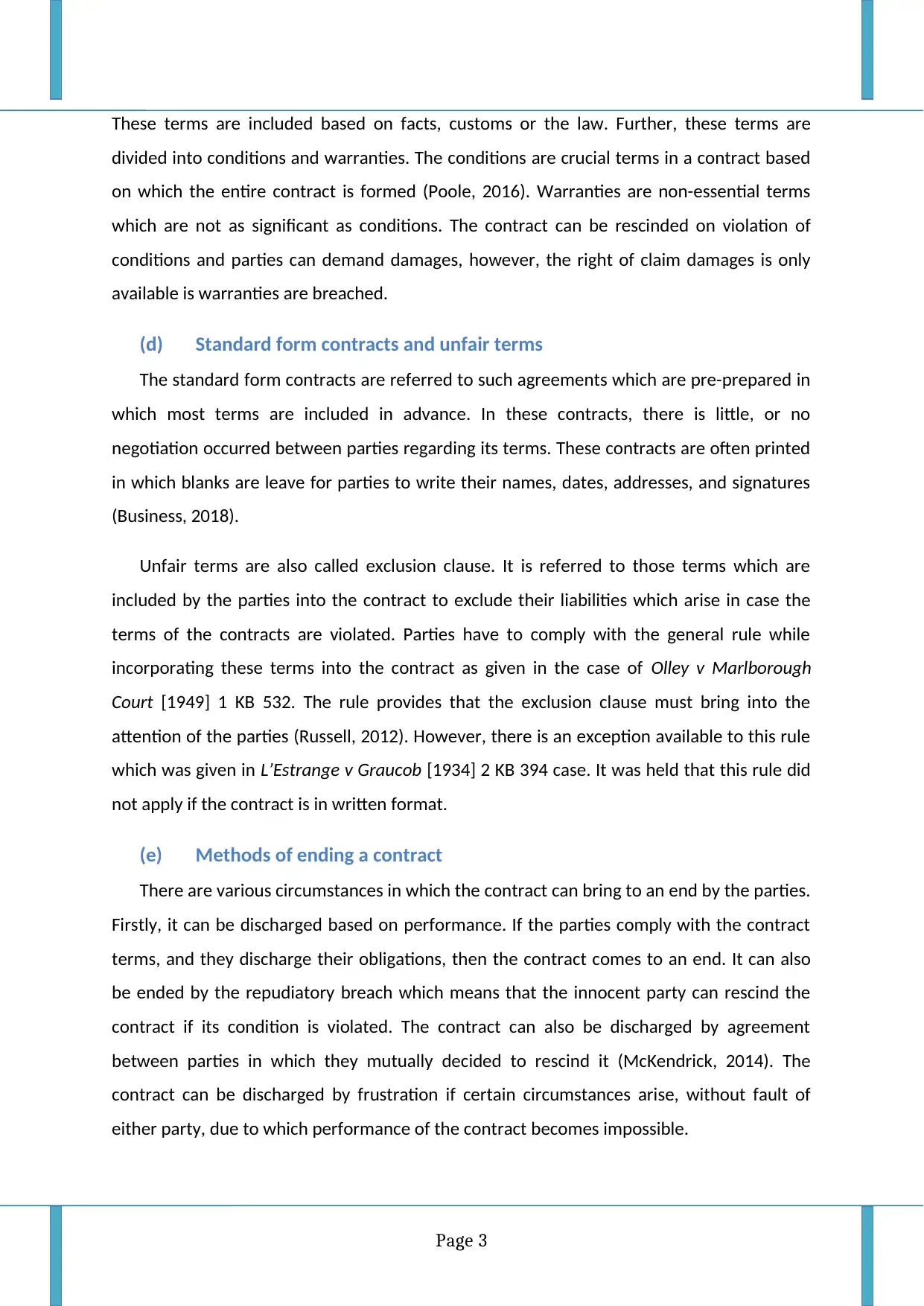
These terms are included based on facts, customs or the law. Further, these terms are
divided into conditions and warranties. The conditions are crucial terms in a contract based
on which the entire contract is formed (Poole, 2016). Warranties are non-essential terms
which are not as significant as conditions. The contract can be rescinded on violation of
conditions and parties can demand damages, however, the right of claim damages is only
available is warranties are breached.
(d) Standard form contracts and unfair terms
The standard form contracts are referred to such agreements which are pre-prepared in
which most terms are included in advance. In these contracts, there is little, or no
negotiation occurred between parties regarding its terms. These contracts are often printed
in which blanks are leave for parties to write their names, dates, addresses, and signatures
(Business, 2018).
Unfair terms are also called exclusion clause. It is referred to those terms which are
included by the parties into the contract to exclude their liabilities which arise in case the
terms of the contracts are violated. Parties have to comply with the general rule while
incorporating these terms into the contract as given in the case of Olley v Marlborough
Court [1949] 1 KB 532. The rule provides that the exclusion clause must bring into the
attention of the parties (Russell, 2012). However, there is an exception available to this rule
which was given in L’Estrange v Graucob [1934] 2 KB 394 case. It was held that this rule did
not apply if the contract is in written format.
(e) Methods of ending a contract
There are various circumstances in which the contract can bring to an end by the parties.
Firstly, it can be discharged based on performance. If the parties comply with the contract
terms, and they discharge their obligations, then the contract comes to an end. It can also
be ended by the repudiatory breach which means that the innocent party can rescind the
contract if its condition is violated. The contract can also be discharged by agreement
between parties in which they mutually decided to rescind it (McKendrick, 2014). The
contract can be discharged by frustration if certain circumstances arise, without fault of
either party, due to which performance of the contract becomes impossible.
Page 3
divided into conditions and warranties. The conditions are crucial terms in a contract based
on which the entire contract is formed (Poole, 2016). Warranties are non-essential terms
which are not as significant as conditions. The contract can be rescinded on violation of
conditions and parties can demand damages, however, the right of claim damages is only
available is warranties are breached.
(d) Standard form contracts and unfair terms
The standard form contracts are referred to such agreements which are pre-prepared in
which most terms are included in advance. In these contracts, there is little, or no
negotiation occurred between parties regarding its terms. These contracts are often printed
in which blanks are leave for parties to write their names, dates, addresses, and signatures
(Business, 2018).
Unfair terms are also called exclusion clause. It is referred to those terms which are
included by the parties into the contract to exclude their liabilities which arise in case the
terms of the contracts are violated. Parties have to comply with the general rule while
incorporating these terms into the contract as given in the case of Olley v Marlborough
Court [1949] 1 KB 532. The rule provides that the exclusion clause must bring into the
attention of the parties (Russell, 2012). However, there is an exception available to this rule
which was given in L’Estrange v Graucob [1934] 2 KB 394 case. It was held that this rule did
not apply if the contract is in written format.
(e) Methods of ending a contract
There are various circumstances in which the contract can bring to an end by the parties.
Firstly, it can be discharged based on performance. If the parties comply with the contract
terms, and they discharge their obligations, then the contract comes to an end. It can also
be ended by the repudiatory breach which means that the innocent party can rescind the
contract if its condition is violated. The contract can also be discharged by agreement
between parties in which they mutually decided to rescind it (McKendrick, 2014). The
contract can be discharged by frustration if certain circumstances arise, without fault of
either party, due to which performance of the contract becomes impossible.
Page 3
Paraphrase This Document
Need a fresh take? Get an instant paraphrase of this document with our AI Paraphraser
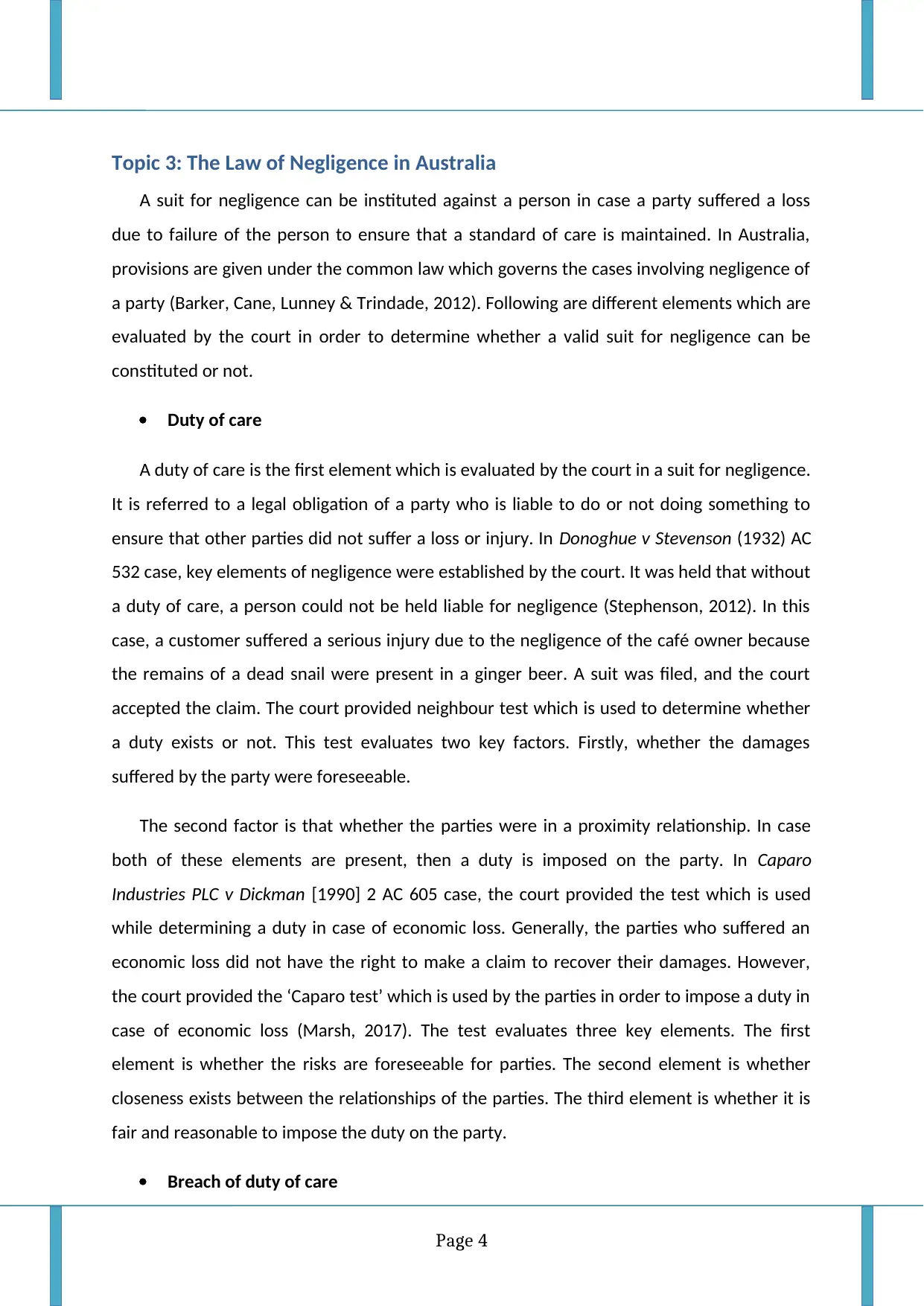
Topic 3: The Law of Negligence in Australia
A suit for negligence can be instituted against a person in case a party suffered a loss
due to failure of the person to ensure that a standard of care is maintained. In Australia,
provisions are given under the common law which governs the cases involving negligence of
a party (Barker, Cane, Lunney & Trindade, 2012). Following are different elements which are
evaluated by the court in order to determine whether a valid suit for negligence can be
constituted or not.
Duty of care
A duty of care is the first element which is evaluated by the court in a suit for negligence.
It is referred to a legal obligation of a party who is liable to do or not doing something to
ensure that other parties did not suffer a loss or injury. In Donoghue v Stevenson (1932) AC
532 case, key elements of negligence were established by the court. It was held that without
a duty of care, a person could not be held liable for negligence (Stephenson, 2012). In this
case, a customer suffered a serious injury due to the negligence of the café owner because
the remains of a dead snail were present in a ginger beer. A suit was filed, and the court
accepted the claim. The court provided neighbour test which is used to determine whether
a duty exists or not. This test evaluates two key factors. Firstly, whether the damages
suffered by the party were foreseeable.
The second factor is that whether the parties were in a proximity relationship. In case
both of these elements are present, then a duty is imposed on the party. In Caparo
Industries PLC v Dickman [1990] 2 AC 605 case, the court provided the test which is used
while determining a duty in case of economic loss. Generally, the parties who suffered an
economic loss did not have the right to make a claim to recover their damages. However,
the court provided the ‘Caparo test’ which is used by the parties in order to impose a duty in
case of economic loss (Marsh, 2017). The test evaluates three key elements. The first
element is whether the risks are foreseeable for parties. The second element is whether
closeness exists between the relationships of the parties. The third element is whether it is
fair and reasonable to impose the duty on the party.
Breach of duty of care
Page 4
A suit for negligence can be instituted against a person in case a party suffered a loss
due to failure of the person to ensure that a standard of care is maintained. In Australia,
provisions are given under the common law which governs the cases involving negligence of
a party (Barker, Cane, Lunney & Trindade, 2012). Following are different elements which are
evaluated by the court in order to determine whether a valid suit for negligence can be
constituted or not.
Duty of care
A duty of care is the first element which is evaluated by the court in a suit for negligence.
It is referred to a legal obligation of a party who is liable to do or not doing something to
ensure that other parties did not suffer a loss or injury. In Donoghue v Stevenson (1932) AC
532 case, key elements of negligence were established by the court. It was held that without
a duty of care, a person could not be held liable for negligence (Stephenson, 2012). In this
case, a customer suffered a serious injury due to the negligence of the café owner because
the remains of a dead snail were present in a ginger beer. A suit was filed, and the court
accepted the claim. The court provided neighbour test which is used to determine whether
a duty exists or not. This test evaluates two key factors. Firstly, whether the damages
suffered by the party were foreseeable.
The second factor is that whether the parties were in a proximity relationship. In case
both of these elements are present, then a duty is imposed on the party. In Caparo
Industries PLC v Dickman [1990] 2 AC 605 case, the court provided the test which is used
while determining a duty in case of economic loss. Generally, the parties who suffered an
economic loss did not have the right to make a claim to recover their damages. However,
the court provided the ‘Caparo test’ which is used by the parties in order to impose a duty in
case of economic loss (Marsh, 2017). The test evaluates three key elements. The first
element is whether the risks are foreseeable for parties. The second element is whether
closeness exists between the relationships of the parties. The third element is whether it is
fair and reasonable to impose the duty on the party.
Breach of duty of care
Page 4
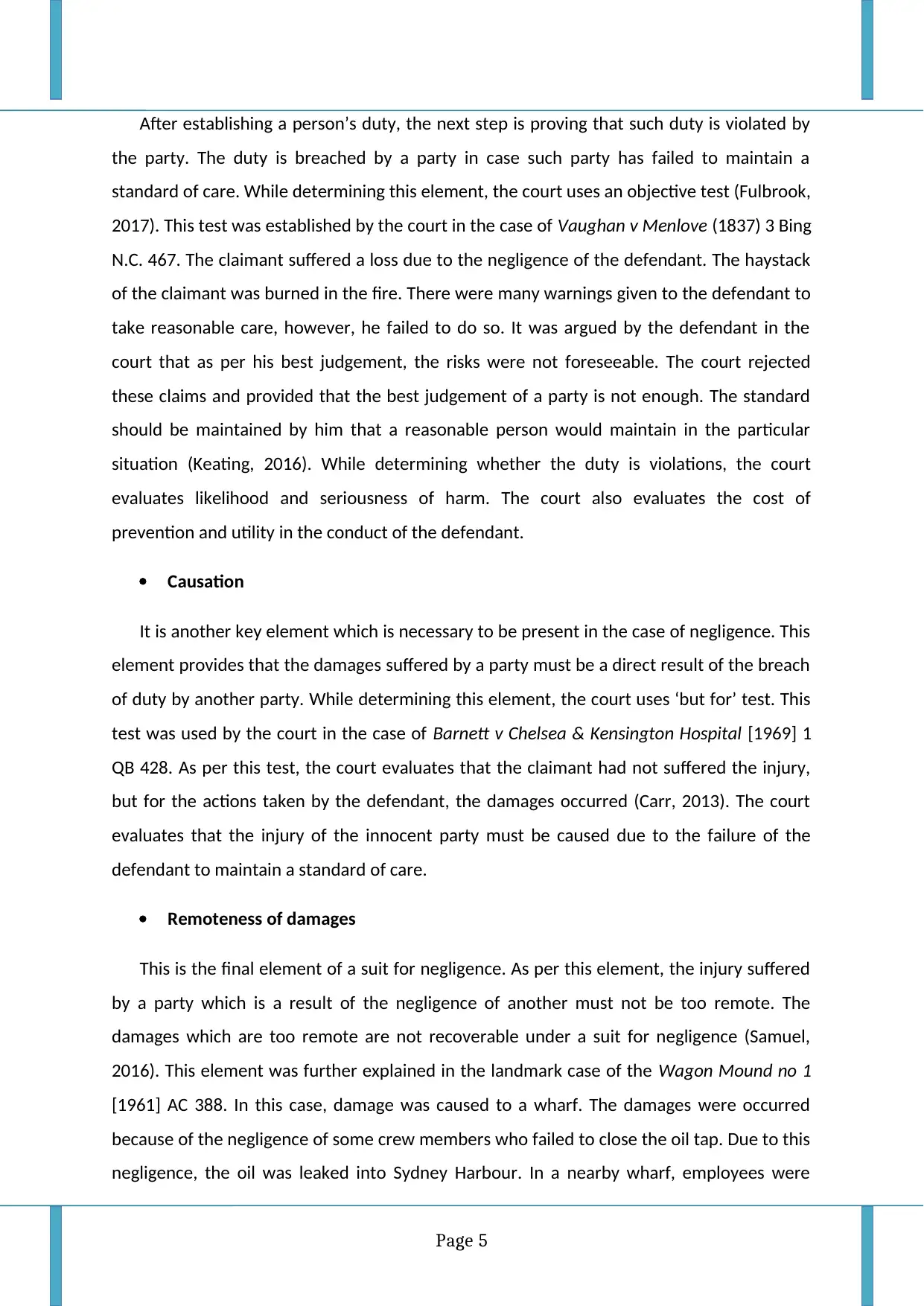
After establishing a person’s duty, the next step is proving that such duty is violated by
the party. The duty is breached by a party in case such party has failed to maintain a
standard of care. While determining this element, the court uses an objective test (Fulbrook,
2017). This test was established by the court in the case of Vaughan v Menlove (1837) 3 Bing
N.C. 467. The claimant suffered a loss due to the negligence of the defendant. The haystack
of the claimant was burned in the fire. There were many warnings given to the defendant to
take reasonable care, however, he failed to do so. It was argued by the defendant in the
court that as per his best judgement, the risks were not foreseeable. The court rejected
these claims and provided that the best judgement of a party is not enough. The standard
should be maintained by him that a reasonable person would maintain in the particular
situation (Keating, 2016). While determining whether the duty is violations, the court
evaluates likelihood and seriousness of harm. The court also evaluates the cost of
prevention and utility in the conduct of the defendant.
Causation
It is another key element which is necessary to be present in the case of negligence. This
element provides that the damages suffered by a party must be a direct result of the breach
of duty by another party. While determining this element, the court uses ‘but for’ test. This
test was used by the court in the case of Barnett v Chelsea & Kensington Hospital [1969] 1
QB 428. As per this test, the court evaluates that the claimant had not suffered the injury,
but for the actions taken by the defendant, the damages occurred (Carr, 2013). The court
evaluates that the injury of the innocent party must be caused due to the failure of the
defendant to maintain a standard of care.
Remoteness of damages
This is the final element of a suit for negligence. As per this element, the injury suffered
by a party which is a result of the negligence of another must not be too remote. The
damages which are too remote are not recoverable under a suit for negligence (Samuel,
2016). This element was further explained in the landmark case of the Wagon Mound no 1
[1961] AC 388. In this case, damage was caused to a wharf. The damages were occurred
because of the negligence of some crew members who failed to close the oil tap. Due to this
negligence, the oil was leaked into Sydney Harbour. In a nearby wharf, employees were
Page 5
the party. The duty is breached by a party in case such party has failed to maintain a
standard of care. While determining this element, the court uses an objective test (Fulbrook,
2017). This test was established by the court in the case of Vaughan v Menlove (1837) 3 Bing
N.C. 467. The claimant suffered a loss due to the negligence of the defendant. The haystack
of the claimant was burned in the fire. There were many warnings given to the defendant to
take reasonable care, however, he failed to do so. It was argued by the defendant in the
court that as per his best judgement, the risks were not foreseeable. The court rejected
these claims and provided that the best judgement of a party is not enough. The standard
should be maintained by him that a reasonable person would maintain in the particular
situation (Keating, 2016). While determining whether the duty is violations, the court
evaluates likelihood and seriousness of harm. The court also evaluates the cost of
prevention and utility in the conduct of the defendant.
Causation
It is another key element which is necessary to be present in the case of negligence. This
element provides that the damages suffered by a party must be a direct result of the breach
of duty by another party. While determining this element, the court uses ‘but for’ test. This
test was used by the court in the case of Barnett v Chelsea & Kensington Hospital [1969] 1
QB 428. As per this test, the court evaluates that the claimant had not suffered the injury,
but for the actions taken by the defendant, the damages occurred (Carr, 2013). The court
evaluates that the injury of the innocent party must be caused due to the failure of the
defendant to maintain a standard of care.
Remoteness of damages
This is the final element of a suit for negligence. As per this element, the injury suffered
by a party which is a result of the negligence of another must not be too remote. The
damages which are too remote are not recoverable under a suit for negligence (Samuel,
2016). This element was further explained in the landmark case of the Wagon Mound no 1
[1961] AC 388. In this case, damage was caused to a wharf. The damages were occurred
because of the negligence of some crew members who failed to close the oil tap. Due to this
negligence, the oil was leaked into Sydney Harbour. In a nearby wharf, employees were
Page 5
⊘ This is a preview!⊘
Do you want full access?
Subscribe today to unlock all pages.

Trusted by 1+ million students worldwide
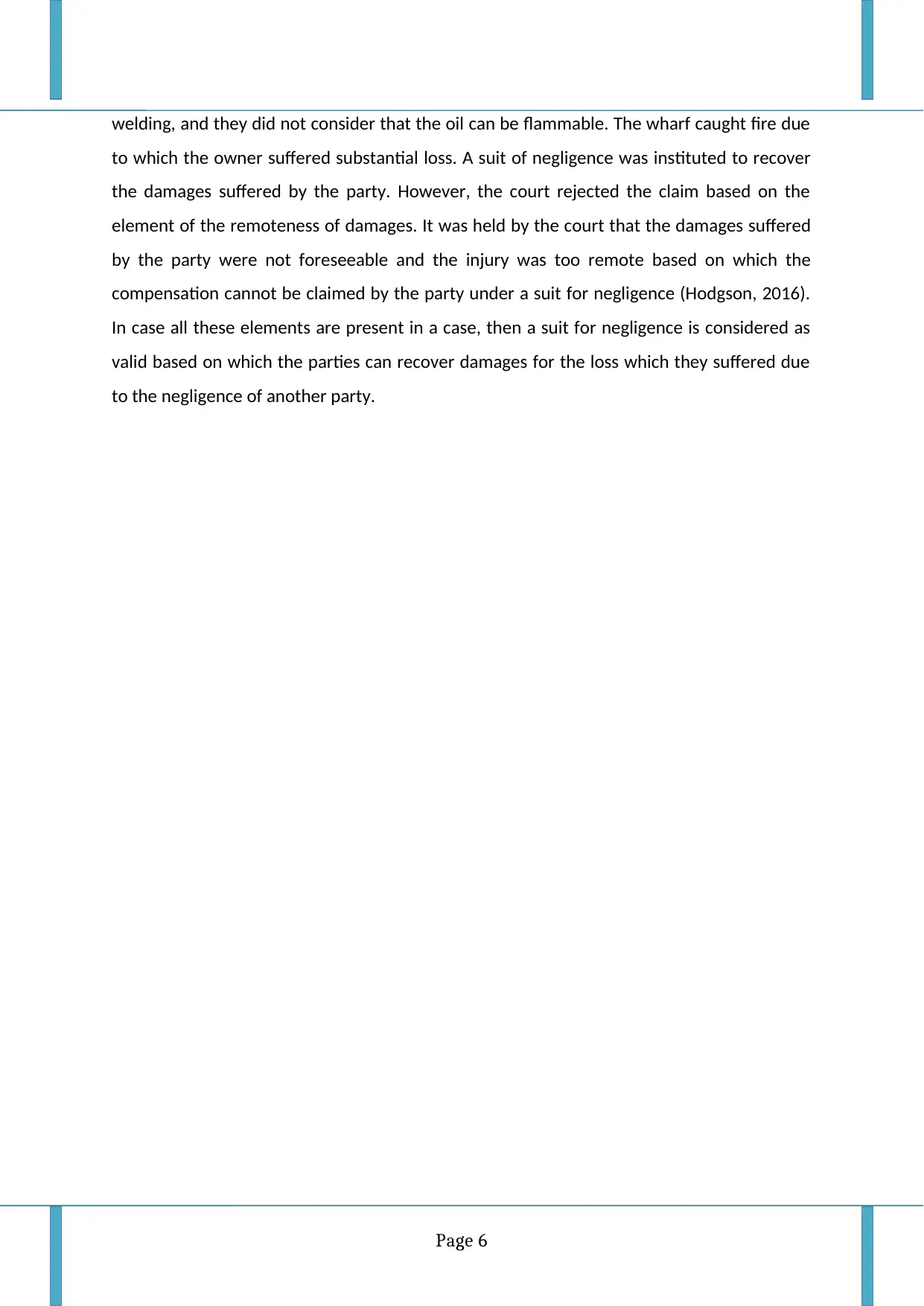
welding, and they did not consider that the oil can be flammable. The wharf caught fire due
to which the owner suffered substantial loss. A suit of negligence was instituted to recover
the damages suffered by the party. However, the court rejected the claim based on the
element of the remoteness of damages. It was held by the court that the damages suffered
by the party were not foreseeable and the injury was too remote based on which the
compensation cannot be claimed by the party under a suit for negligence (Hodgson, 2016).
In case all these elements are present in a case, then a suit for negligence is considered as
valid based on which the parties can recover damages for the loss which they suffered due
to the negligence of another party.
Page 6
to which the owner suffered substantial loss. A suit of negligence was instituted to recover
the damages suffered by the party. However, the court rejected the claim based on the
element of the remoteness of damages. It was held by the court that the damages suffered
by the party were not foreseeable and the injury was too remote based on which the
compensation cannot be claimed by the party under a suit for negligence (Hodgson, 2016).
In case all these elements are present in a case, then a suit for negligence is considered as
valid based on which the parties can recover damages for the loss which they suffered due
to the negligence of another party.
Page 6
Paraphrase This Document
Need a fresh take? Get an instant paraphrase of this document with our AI Paraphraser
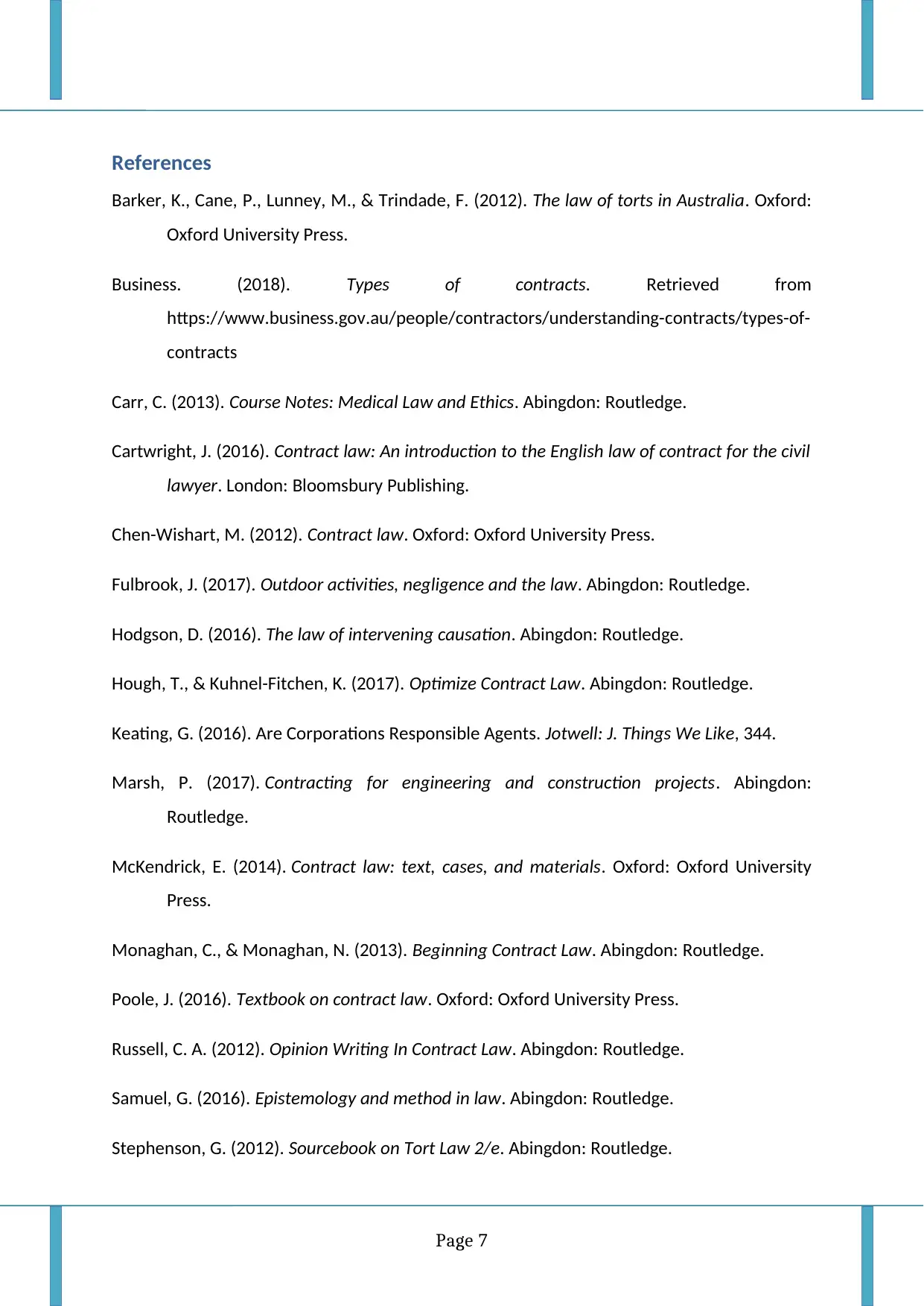
References
Barker, K., Cane, P., Lunney, M., & Trindade, F. (2012). The law of torts in Australia. Oxford:
Oxford University Press.
Business. (2018). Types of contracts. Retrieved from
https://www.business.gov.au/people/contractors/understanding-contracts/types-of-
contracts
Carr, C. (2013). Course Notes: Medical Law and Ethics. Abingdon: Routledge.
Cartwright, J. (2016). Contract law: An introduction to the English law of contract for the civil
lawyer. London: Bloomsbury Publishing.
Chen-Wishart, M. (2012). Contract law. Oxford: Oxford University Press.
Fulbrook, J. (2017). Outdoor activities, negligence and the law. Abingdon: Routledge.
Hodgson, D. (2016). The law of intervening causation. Abingdon: Routledge.
Hough, T., & Kuhnel-Fitchen, K. (2017). Optimize Contract Law. Abingdon: Routledge.
Keating, G. (2016). Are Corporations Responsible Agents. Jotwell: J. Things We Like, 344.
Marsh, P. (2017). Contracting for engineering and construction projects. Abingdon:
Routledge.
McKendrick, E. (2014). Contract law: text, cases, and materials. Oxford: Oxford University
Press.
Monaghan, C., & Monaghan, N. (2013). Beginning Contract Law. Abingdon: Routledge.
Poole, J. (2016). Textbook on contract law. Oxford: Oxford University Press.
Russell, C. A. (2012). Opinion Writing In Contract Law. Abingdon: Routledge.
Samuel, G. (2016). Epistemology and method in law. Abingdon: Routledge.
Stephenson, G. (2012). Sourcebook on Tort Law 2/e. Abingdon: Routledge.
Page 7
Barker, K., Cane, P., Lunney, M., & Trindade, F. (2012). The law of torts in Australia. Oxford:
Oxford University Press.
Business. (2018). Types of contracts. Retrieved from
https://www.business.gov.au/people/contractors/understanding-contracts/types-of-
contracts
Carr, C. (2013). Course Notes: Medical Law and Ethics. Abingdon: Routledge.
Cartwright, J. (2016). Contract law: An introduction to the English law of contract for the civil
lawyer. London: Bloomsbury Publishing.
Chen-Wishart, M. (2012). Contract law. Oxford: Oxford University Press.
Fulbrook, J. (2017). Outdoor activities, negligence and the law. Abingdon: Routledge.
Hodgson, D. (2016). The law of intervening causation. Abingdon: Routledge.
Hough, T., & Kuhnel-Fitchen, K. (2017). Optimize Contract Law. Abingdon: Routledge.
Keating, G. (2016). Are Corporations Responsible Agents. Jotwell: J. Things We Like, 344.
Marsh, P. (2017). Contracting for engineering and construction projects. Abingdon:
Routledge.
McKendrick, E. (2014). Contract law: text, cases, and materials. Oxford: Oxford University
Press.
Monaghan, C., & Monaghan, N. (2013). Beginning Contract Law. Abingdon: Routledge.
Poole, J. (2016). Textbook on contract law. Oxford: Oxford University Press.
Russell, C. A. (2012). Opinion Writing In Contract Law. Abingdon: Routledge.
Samuel, G. (2016). Epistemology and method in law. Abingdon: Routledge.
Stephenson, G. (2012). Sourcebook on Tort Law 2/e. Abingdon: Routledge.
Page 7

Turner, C. (2013). Contract law. Abingdon: Routledge.
Page 8
Page 8
⊘ This is a preview!⊘
Do you want full access?
Subscribe today to unlock all pages.

Trusted by 1+ million students worldwide
1 out of 9
Related Documents
Your All-in-One AI-Powered Toolkit for Academic Success.
+13062052269
info@desklib.com
Available 24*7 on WhatsApp / Email
![[object Object]](/_next/static/media/star-bottom.7253800d.svg)
Unlock your academic potential
Copyright © 2020–2025 A2Z Services. All Rights Reserved. Developed and managed by ZUCOL.




